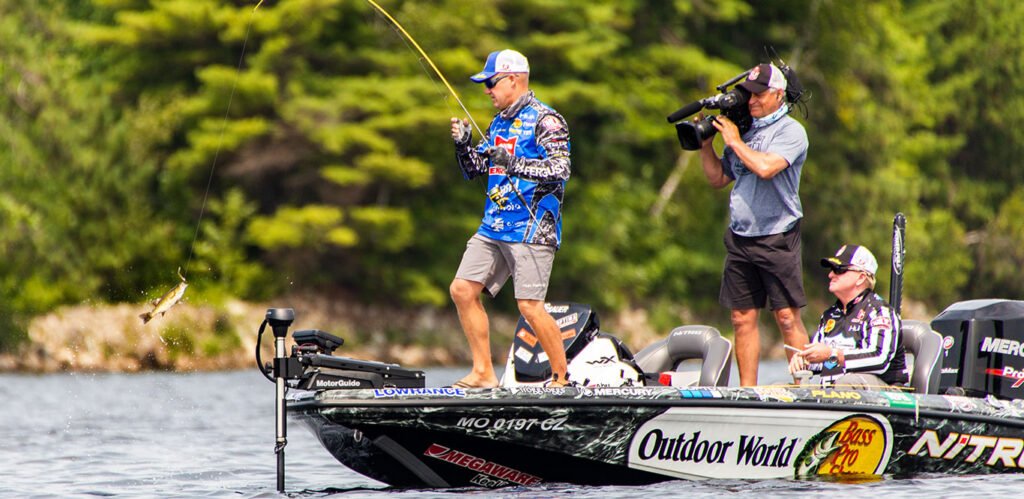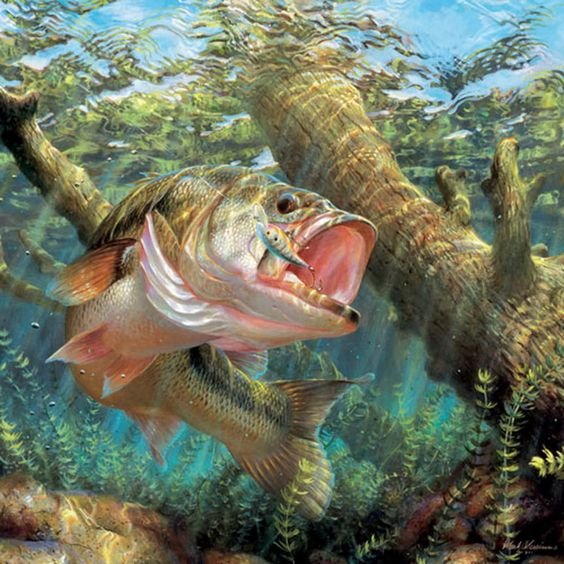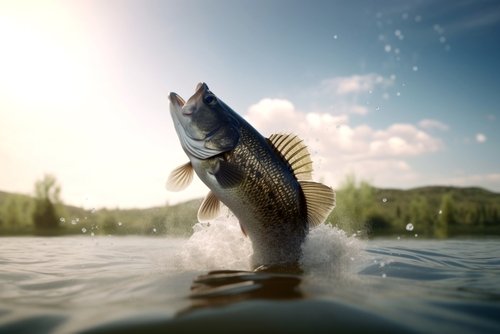In the realm of competitive fishing, Major League Fishing (MLF) has emerged as a revolutionary force. This article aims to explore Major League Fishing and intriguing history and evolution.

Overview of Major League Fishing (MLF)
Major League Fishing can be described as an angling tournament series that brings together top-level professional bass anglers to compete in a highly competitive and fast-paced environment.
Unlike traditional tournaments that follow a fixed time frame or weigh-in restrictions, MLF offers a dynamic approach where anglers strive to catch as many qualifying fish as possible within a set period. The central aspect that sets MLF apart from other tournaments is its innovative scoring system called the “Major League Fishing Scoretracker.”
This real-time scoring system allows participants and viewers to track individual Angler’s performance throughout the event.
Rather than relying solely on fish weight, MLF also values quantity by awarding points for every fish caught. This distinct scoring methodology ensures an exciting narrative unfolds throughout each competition.
Brief History and Evolution of MLF
The genesis of Major League Fishing can be traced back to 2011 when iconic professional anglers Boyd Duckett and Gary Klein conceptualized a new format designed to showcase the skill and strategy involved in bass fishing.
The inaugural season took place in 2012 with six events featuring 24 prominent anglers who were hand-picked based on their accomplishments in previous tournaments. As the popularity of MLF soared among fans hungry for more angling action, several notable changes were introduced to enhance the competition’s appeal.
In 2019, the Bass Pro Tour was launched due to a partnership between Major League Fishing and Outdoor Sportsman Group. This move solidified MLF’s presence in the professional bass fishing arena. This evolution expanded the tournament schedule and brought about larger prize pools, increased media coverage, and heightened sponsorship opportunities.
The Format and Rules of MLF
Scoring System: The “Major League Fishing Scoretracker”
The Major League Fishing Scoretracker is a revolutionary scoring system that sets MLF apart from traditional fishing tournaments. It brings transparency and excitement to the competition by allowing real-time updates on angler standings throughout the event.
The Scoretracker operates on a digital platform, providing viewers an interactive experience following the tournament action. How the Scoretracker works: Each Angler wears a real-time tracking device that records their catches.
When anglers catch a fish, they enter the details into their handheld device, including the species, weight, and catch time. This information is then transmitted to the central database and displayed on live leaderboards accessible to anglers and fans alike.
Scoring based on weight and quantity of fish caught: In Major League Fishing, every fish caught counts towards a competitor’s score. Anglers are awarded points based on both weight and quantity of fish caught during a specified period.
For example, if an angler catches five bass weighing 10 pounds in total while another only catches three bass weighing 8 pounds, the first Angler would be ahead in points despite catching fewer fish. This emphasis on both weight and quantity ensures that anglers strive for consistent success throughout each round of competition.
Time Management: The “Shot Clock”
One of the most unique aspects of Major League Fishing is its implementation of a Shot Clock concept borrowed from other sports like basketball or chess. The Shot Clock adds an element of urgency to each Angler’s decision-making process during each round. Explanation of the Shot Clock concept: Every competitor has a specific amount of time allotted for each cast or presentation before moving to another spot or making adjustments.
The duration varies depending on the tournament and round but typically ranges from 30 seconds to a few minutes. Anglers must make crucial decisions quickly, constantly analyzing conditions, evaluating their strategy, and adapting to maximize their chances of catching fish within the time constraints.
Impact on anglers’ decision-making process: The Shot Clock adds an exhilarating layer of pressure to MLF tournaments. Anglers must balance efficiency with accuracy as they choose when and where to fish.
They must consider factors such as water conditions, weather patterns, and previous catches to make precise decisions within the limited time frame. This dynamic aspect of MLF challenges competitors to think on their feet and trust their instincts, ultimately enhancing the excitement for participants and spectators alike.
The MLF Tournament Structure
Qualifying Rounds: “Elimination Rounds”
Under the thrilling structure of Major League Fishing (MLF) tournaments, the competition unfolds in a series of qualifying rounds known as “Elimination Rounds.” In these rounds, many anglers compete against each other for the chance to advance further in the tournament. Typically, each qualifying round consists of approximately 40 to 50 anglers battling head-to-head on various lakes and bodies of water carefully chosen by MLF organizers. These locations are strategically selected to provide diverse fishing conditions and challenges, ensuring an equitable playing field for all participants.
Each qualifying round’s duration varies depending on weather conditions and lake size. Generally, these rounds span two or three days, giving anglers ample time to demonstrate their skills and adapt to the unique nuances of each fishing location.
Throughout this phase, competitors face intense pressure from their opponents and time limitations imposed by MLF’s innovative format. The objective is clear: catch as many high-quality fish as possible within the allotted time frame while adhering to strict rules and regulations set forth by MLF.
Championship Round: “Sudden Death” or “Finals”
After enduring the grueling qualifying rounds, only a select group of top-performing anglers advance to the highly anticipated championship round, aptly called “Sudden Death” or simply “Finals.” This stage is characterized by heightened pressure and increased intensity as these elite contenders vie for ultimate victory. The format ensures that only a few exceptional individuals have the opportunity to compete in this climactic finale.
The precise number of anglers progressing to the championship round depends on tournament size and structure. Typically, six to twelve participants make it through based on their performance during the qualifying rounds.
As they enter this showdown, these skilled anglers face off against each other with their accumulated weights reset to zero, effectively leveling the playing field and creating an atmosphere of uncertainty. In the championship round, every cast, every decision, and every catch carries immense weight.
The pressure to perform at their absolute best is palpable as anglers aim to secure victory and the prestigious titles of MLF tournaments. This intense climax showcases the true essence of Major League Fishing as exceptional athletes navigate the challenges presented by nature and their fellow competitors in a fight for fishing supremacy.
Unique Features of MLF Tournaments
No Practice Days: Leveling the Playing Field
Unlike traditional fishing tournaments, Major League Fishing (MLF) introduces a captivating element by eliminating the typical practice days. This means that participating anglers are restricted from scouting or preparing for the tournament in advance, rendering them wholly reliant on their instincts and skills during the competition. This novel approach levels the playing field, removing any potential advantage from extensive pre-tournament research or familiarity with the fishing location.
The absence of practice days in MLF tournaments places a premium on adaptability and quick decision-making skills. Anglers must rely solely on their ability to assess prevailing conditions, including water temperature, weather patterns, and fish behavior during the event.
Without prior knowledge of the fishing location, competitors must think on their feet and rapidly adjust their strategies based on real-time observations. The emphasis thus shifts from preparation to execution, testing an angler’s ability to adapt their techniques effectively and react swiftly to changing circumstances.
Live Coverage: Enhancing Fan Experience
One of the most notable features that sets MLF apart is its live coverage of tournaments, which greatly enhances the fan experience. Through streaming platforms and dedicated broadcasts, fishing enthusiasts can follow every moment of action in real-time. Gone are the days when fans had to wait for weigh-ins patiently or rely solely on post-tournament summaries; now, they can engage with every cast and catch as if they were on the boat themselves.
With live coverage come many benefits for fans eager for more than just results. Streaming platforms provide viewers with real-time updates on anglers’ progress throughout each event – a thrilling experience as positions constantly fluctuate based on successful catches.
Additionally, expert commentary offers valuable insights into various angler techniques and analyzes shifting conditions and their impact on the tournament. Furthermore, MLF’s commitment to behind-the-scenes access allows fans to glimpse the world of professional fishing, fostering a deeper connection between spectators and their favorite anglers.
Major League Fishing offers a unique and captivating tournament experience by eliminating practice days and incorporating live coverage. The absence of pre-tournament scouting levels the playing field, placing importance on adaptability and quick decision-making skills.
Meanwhile, live-streaming platforms bring fans closer to the action than ever, providing real-time updates, insightful commentary, and behind-the-scenes access. These distinctive features have propelled MLF to become a beloved entity in the professional bass fishing industry while captivating audiences worldwide.
Prominent Anglers and Their Achievements in MLF
The Elite Cast: Recognizing the Icons of Major League Fishing
Major League Fishing boasts a roster of incredibly talented anglers with unique skills and accomplishments. One such Angler is Kevin VanDam, whose name is synonymous with bass fishing excellence.
VanDam has an unparalleled track record, winning four Bassmaster Classic championships and seven Angler of the Year titles. His ability to consistently locate and catch fish under various conditions has made him a force reckoned with in the MLF tournaments.
Another prominent figure in Major League Fishing is Jacob Wheeler, a young prodigy who burst onto the scene with remarkable success. Wheeler became the youngest Angler to win the FLW Cup at just 21 years old.
His exceptional versatility on different bodies of water and ability to adapt quickly has earned him multiple victories in MLF events. Wheeler’s strategic approach involves studying patterns meticulously and capitalizing on specific nuances that give him an edge over his competitors.
Strategies that Make Champions: Unveiling Unique Approaches
Within Major League Fishing, each Angler brings their distinct style and strategy to the competition. Take Mike Iaconelli, a passionate and energetic angler known for his aggressive approach.
Iaconelli’s “power fishing” technique involves quickly covering vast amounts of water, targeting active fish using fast-moving baits like crankbaits or spinnerbaits. This dynamic strategy allows him to generate bites rapidly while tapping into his expert instincts.
In contrast, Edwin Evers employs a more finesse-oriented approach emphasizing precision casting and meticulous lure presentation. Known for his phenomenal consistency across seasons, Evers exploits subtle changes in water conditions or fish behavior to maximize his chances of success during crucial moments in MLF tournaments.
By carefully analyzing every detail, Evers can adjust his technique accordingly and capitalize on the smallest windows of opportunity. These are just a few examples of the exceptional anglers within Major League Fishing.
Each possesses its distinct approach, whether a high-energy power technique or a finesse-oriented finesse style. Their accomplishments and innovative strategies continue to captivate audiences worldwide while setting new standards in professional bass fishing.
Impact on the Professional Bass Fishing Industry
Influence on traditional tournaments
The advent of Major League Fishing (MLF) has profoundly impacted the professional bass fishing industry, particularly in its influence on traditional tournaments. The unique format and rules of MLF have forced traditional tournament organizers to reconsider their approaches and adjust to remain competitive in attracting both anglers and fans. One aspect that has been influenced is the scoring system.
MLF’s emphasis on catching as many fish as possible within a specific timeframe has highlighted the limitations of the traditional weight-based scoring system in many tournaments. Anglers are now more aware of the need for quantity and quality, leading to strategy shifts during traditional tournaments.
Additionally, some tournaments have even adopted elements from MLF, such as implementing real-time scoreboards or using a modified leaderboard format. The increased popularity of MLF has also raised the bar for fan engagement and media coverage expectations.
The live coverage with real-time updates through streaming platforms and enhanced commentary provided by MLF has set new standards for how fishing tournaments are presented to audiences. Traditional tournament organizers have recognized this shift and started investing more resources into improving their media coverage, whether through live streaming, social media updates, or post-event analysis shows.
Conclusion
Major League Fishing (MLF) has undoubtedly left an indelible mark on the professional bass fishing industry. Its innovative format and rule changes have disrupted long-standing conventions within the sport. By challenging anglers’ skills with its unique scoring system and emphasizing adaptability through time management, MLF has pushed competitors to elevate their game.
Furthermore, MLF’s influence extends beyond its events, prompting traditional tournament organizers to reevaluate their approaches by incorporating elements from this new format. This push for improvement benefits anglers and fans by providing more exciting and engaging events.
Ultimately, MLF has injected renewed energy and enthusiasm into professional bass fishing, attracting new audiences and inspiring a generation of anglers. With its continued growth and impact on the industry, there is every reason to be optimistic about the future of the sport.





